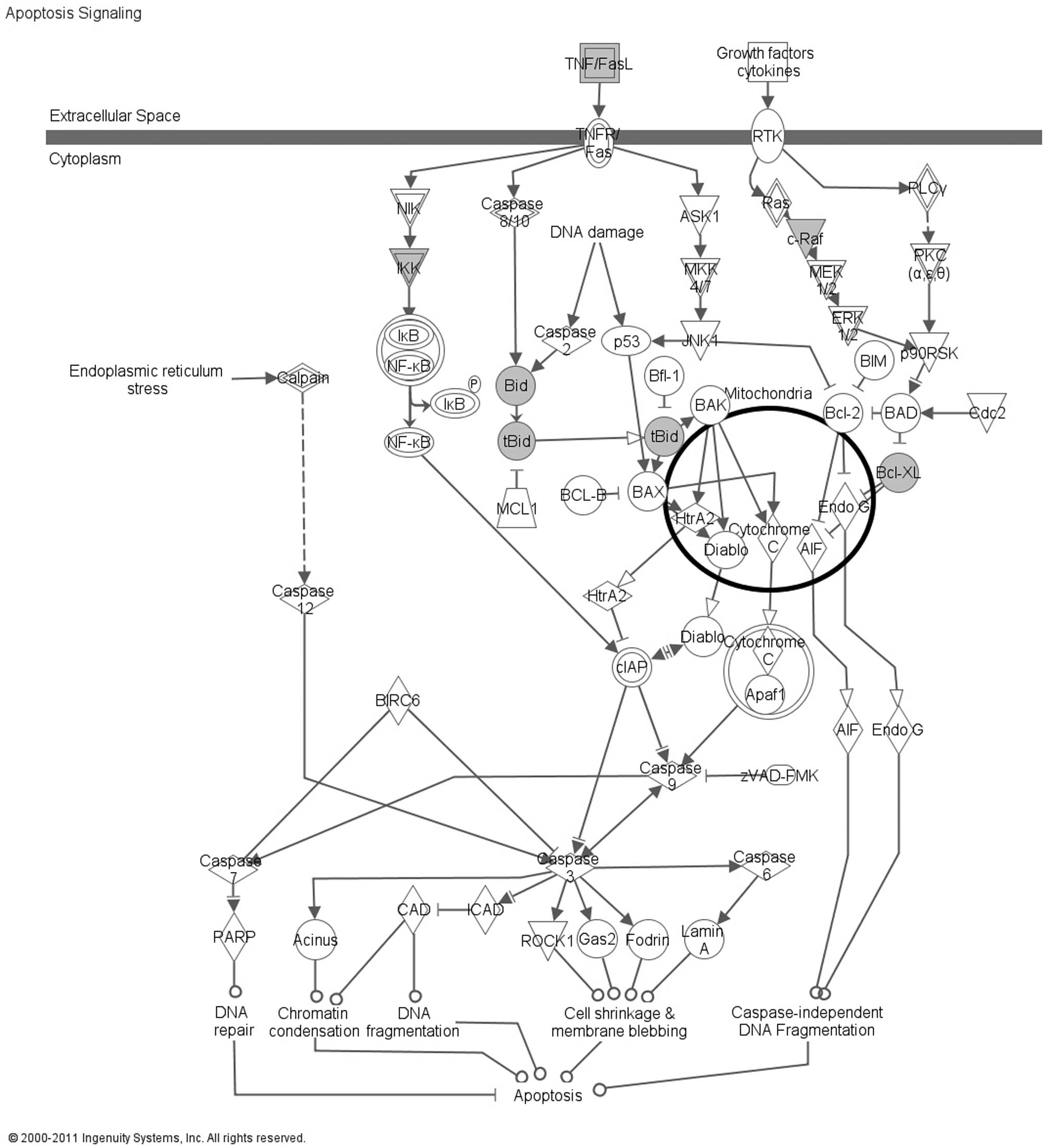|
1
|
Hull MA: Cyclooxygenase-2: how good is it
as a target for cancer chemoprevention? Eur J Cancer. 41:1854–1863.
2005. View Article : Google Scholar : PubMed/NCBI
|
|
2
|
Gasparini G, Longo R, Sarmiento R and
Morabito A: Inhibitors of cyclo-oxygenase 2: a new class of
anticancer agents? Lancet Oncol. 4:605–615. 2003. View Article : Google Scholar : PubMed/NCBI
|
|
3
|
Rao P and Knaus E: Evolution of
nonsteroidal antiinflammatory drugs (NSAIDS): cyclooxygenase (COX)
inhibition and beyond. J Pharm Pharm Sci. 11:81S–110S.
2008.PubMed/NCBI
|
|
4
|
Ghosh N, Chaki R, Mandal V and Mandal SC:
COX-2 as a target for cancer chemotherapy. Pharmacol Rep.
62:233–244. 2010. View Article : Google Scholar : PubMed/NCBI
|
|
5
|
Menter DG, Schilsky RL and DuBois RN:
Cyclooxygenase-2 and cancer treatment: understanding the risk
should be worth the reward. Clin Cancer Res. 16:1384–1390. 2010.
View Article : Google Scholar : PubMed/NCBI
|
|
6
|
Baldi A, Santini D, Vasaturo F, et al:
Prognostic significance of cyclooxygenase-2 (COX-2) and expression
of cell cycle inhibitors p21 and p27 in human pleural malignant
mesothelioma. Thorax. 59:428–433. 2004. View Article : Google Scholar : PubMed/NCBI
|
|
7
|
Edwards JG, Faux SP, Plummer SM, et al:
Cyclooxygenase-2 expression is a novel prognostic factor in
malignant mesothelioma. Clin Cancer Res. 8:1857–1862.
2002.PubMed/NCBI
|
|
8
|
Marrogi A, Pass HI, Khan M, Metheny-Barlow
LJ, Harris CC and Gerwin BI: Human mesothelioma samples overexpress
both cyclooxygenase-2 (COX-2) and inducible nitric oxide synthase
(NOS2): in vitro antiproliferative effects of a COX-2 inhibitor.
Cancer Res. 60:3696–3700. 2000.
|
|
9
|
Cardillo I, Spugnini EP, Verdina A, Galati
R, Citro G and Baldi A: Cox and mesothelioma: an overview. Histol
Histopathol. 20:1267–1274. 2005.PubMed/NCBI
|
|
10
|
O’Kane SL, Cawkwell L, Campbell A and Lind
MJ: Cyclooxygenase-2 expression predicts survival in malignant
pleural mesothelioma. Eur J Cancer. 41:1645–1648. 2005.PubMed/NCBI
|
|
11
|
Catalano A, Graciotti L, Rinaldi L, et al:
Preclinical evaluation of the nonsteroidal anti-inflammatory agent
celecoxib on malignant mesothelioma chemoprevention. Int J Cancer.
109:322–328. 2004. View Article : Google Scholar : PubMed/NCBI
|
|
12
|
O’Kane SL, Eagle GL, Greenman J, Lind MJ
and Cawkwell L: COX-2 specific inhibitors enhance the cytotoxic
effects of pemetrexed in mesothelioma cell lines. Lung Cancer.
67:160–165. 2010.PubMed/NCBI
|
|
13
|
Blobaum AL and Marnett LJ: Structural and
functional basis of cyclooxygenase inhibition. J Med Chem.
50:1425–1441. 2007. View Article : Google Scholar : PubMed/NCBI
|
|
14
|
Scagliotti GV, Parikh P, von Pawel J, et
al: Phase III study comparing cisplatin plus gemcitabine with
cisplatin plus pemetrexed in chemotherapy-naive patients with
advanced-stage non-small-cell lung cancer. J Clin Oncol.
26:3543–3551. 2008. View Article : Google Scholar : PubMed/NCBI
|
|
15
|
Vogelzang NJ, Rusthoven JJ, Symanowski J,
et al: Phase III study of pemetrexed in combination with cisplatin
versus cisplatin alone in patients with malignant pleural
mesothelioma. J Clin Oncol. 21:2636–2644. 2003. View Article : Google Scholar : PubMed/NCBI
|
|
16
|
Churchman A, Baydoun AR and Hoffman R:
Inhibition of angiogenic tubule formation and induction of
apoptosis in human endothelial cells by the selective
cyclooxygenase-2 inhibitor
5-bromo-2-(4-fluorophenyl)-3-(methylsulfonyl) thiophene (DuP-697).
Eur J Pharmacol. 573:176–183. 2007. View Article : Google Scholar
|
|
17
|
Peng HL, Zhang GS, Liu JH, Gong FJ and Li
RJ: Dup-697, a specific COX-2 inhibitor, suppresses growth and
induces apoptosis on K562 leukemia cells by cell-cycle arrest and
caspase-8 activation. Ann Hematol. 87:121–129. 2008. View Article : Google Scholar : PubMed/NCBI
|
|
18
|
Hodgkinson VC, Elfadl D, Drew PJ, Lind MJ
and Cawkwell L: Repeatedly identified differentially expressed
proteins (RIDEPs) from antibody microarray proteomic analysis. J
Proteomics. 74:698–703. 2011. View Article : Google Scholar
|
|
19
|
Danial NN: BCL-2 family proteins: critical
checkpoints of apoptotic cell death. Clin Cancer Res. 13:7254–7263.
2007. View Article : Google Scholar : PubMed/NCBI
|
|
20
|
Song G, Chen G, Hu T and Lai PB: Bid
stands at the crossroad of stress-response pathways. Curr Cancer
Drug Targets. 10:584–592. 2010. View Article : Google Scholar : PubMed/NCBI
|
|
21
|
Strasser A, Cory S and Adams JM:
Deciphering the rules of programmed cell death to improve therapy
of cancer and other diseases. EMBO J. 30:3667–3683. 2011.
View Article : Google Scholar : PubMed/NCBI
|
|
22
|
Kern MA, Haugg AM, Koch AF, et al:
Cyclooxygenase-2 inhibition induces apoptosis signaling via death
receptors and mitochondria in hepatocellular carcinoma. Cancer Res.
66:7059–7066. 2006. View Article : Google Scholar : PubMed/NCBI
|
|
23
|
Lou J, Fatima N, Xiao Z, et al: Proteomic
profiling identifies cyclooxygenase-2-independent global proteomic
changes by celecoxib in colorectal cancer cells. Cancer Epidemiol
Biomarkers Prev. 15:1598–1606. 2006. View Article : Google Scholar
|
|
24
|
Pang RP, Zhou JG, Zeng ZR, et al:
Celecoxib induces apoptosis in COX-2 deficient human gastric cancer
cells through Akt/GSK3beta/NAG-1 pathway. Cancer Lett. 251:268–277.
2007. View Article : Google Scholar : PubMed/NCBI
|
|
25
|
Schonthal AH: Direct non-cyclooxygenase-2
targets of celecoxib and their potential relevance for cancer
therapy. Br J Cancer. 97:1465–1468. 2007. View Article : Google Scholar : PubMed/NCBI
|













